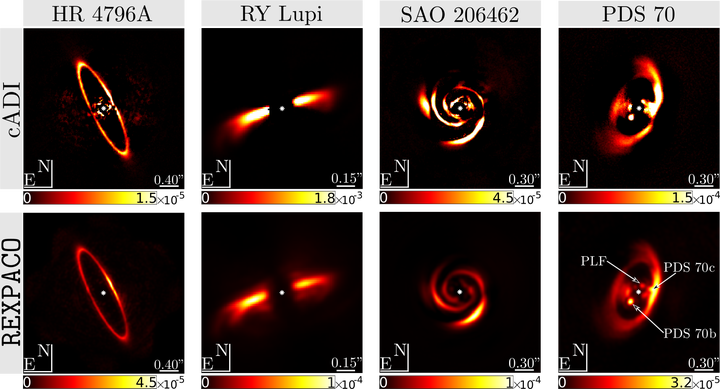REXPACO: An algorithm for high contrast reconstruction of the circumstellar environment by angular differential imaging
Astronomy & Astrophysics, vol. 651, A62
 Examples of disk reconstructions obtained with REXPACO comparatively to a standard method (cADI).
Examples of disk reconstructions obtained with REXPACO comparatively to a standard method (cADI).
Abstract
Context. Direct imaging is a method of choice for probing the close environment of young stars. Even with the coupling of adaptive optics and coronagraphy, the direct detection of off-axis sources such as circumstellar disks and exoplanets remains challenging due to the required high contrast and small angular resolution. Angular differential imaging (ADI) is an observational technique that introduces an angular diversity to help disentangle the signal of off-axis sources from the residual signal of the star in a post-processing step.
Aims. While various detection algorithms have been proposed in the last decade to process ADI sequences and reach high contrast for the detection of point-like sources, very few methods are available to reconstruct meaningful images of extended features such as circumstellar disks. The purpose of this paper is to describe a new post-processing algorithm dedicated to the reconstruction of the spatial distribution of light (total intensity) received from off-axis sources, in particular from circumstellar disks.
Methods. Built on the recent PACO algorithm dedicated to the detection of point-like sources, the proposed method is based on the local learning of patch covariances capturing the spatial fluctuations of the stellar leakages. From this statistical modeling, we develop a regularized image reconstruction algorithm (REXPACO) following an inverse problems approach based on a forward image formation model of the off-axis sources in the ADI sequences.
Results. Injections of fake circumstellar disks in ADI sequences from the VLT/SPHERE-IRDIS instrument show that both the morphology and the photometry of the disks are better preserved by REXPACO compared to standard postprocessing methods such as cADI. In particular, the modeling of the spatial covariances proves useful in reducing typical ADI artifacts and in better disentangling the signal of these sources from the residual stellar contamination. The application to stars hosting circumstellar disks with various morphologies confirms the ability of REXPACO to produce images of the light distribution with reduced artifacts. Finally, we show how REXPACO can be combined with PACO to disentangle the signal of circumstellar disks from the signal of candidate point-like sources.
Conclusions. REXPACO is a novel post-processing algorithm for reconstructing images of the circumstellar environment from high contrast ADI sequences. It produces numerically deblurred images and exploits the spatial covariances of the stellar leakages and of the noise to efficiently eliminate this nuisance term. The processing is fully unsupervised, all tuning parameters being directly estimated from the data themselves.